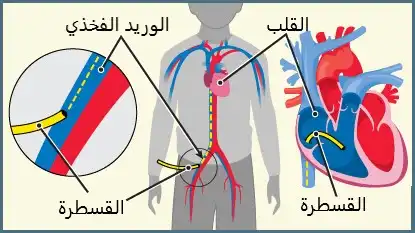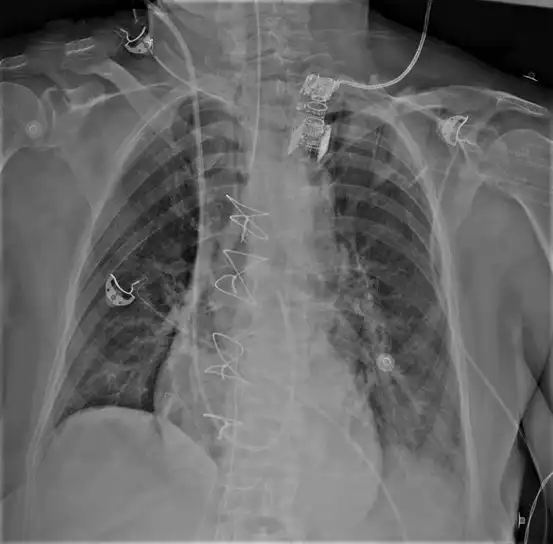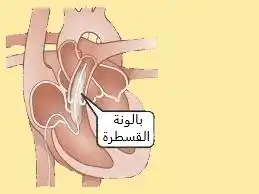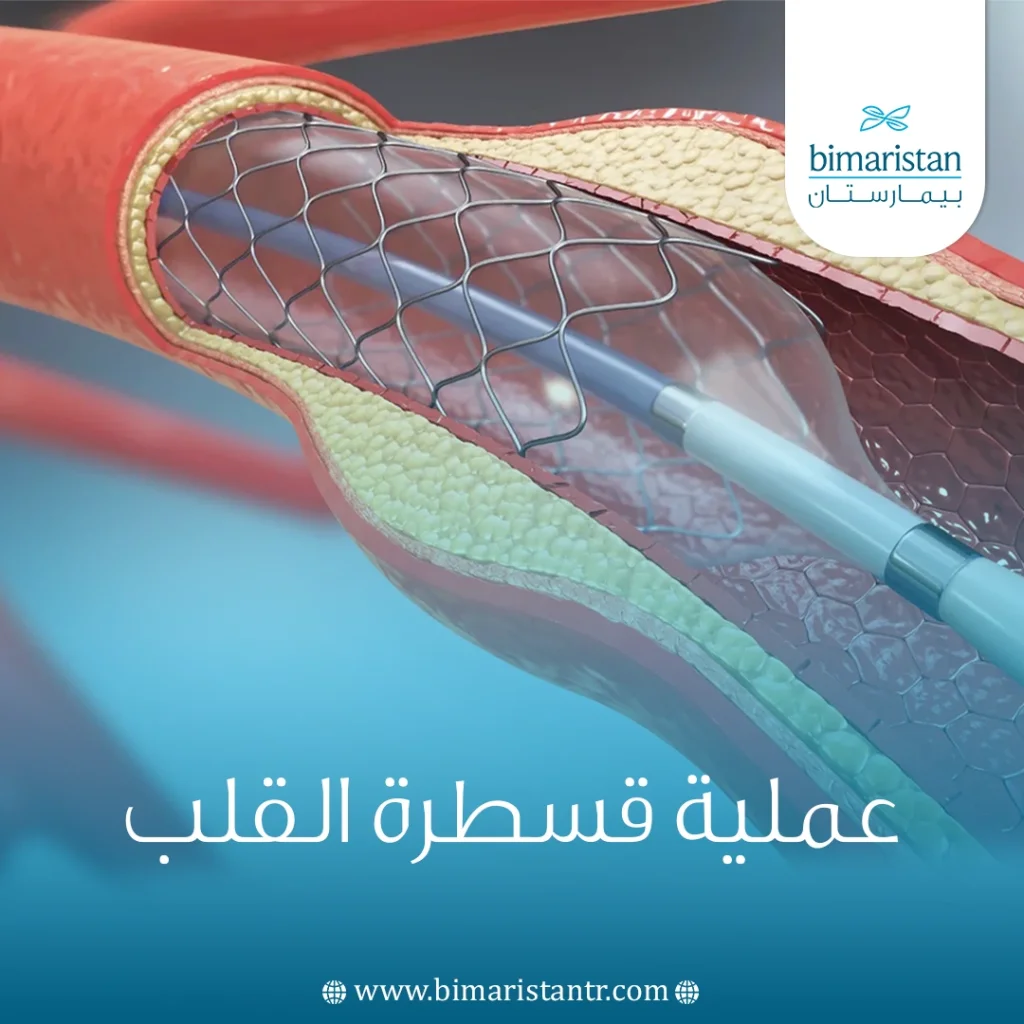عملية قسطرة القلب أو ما يدعى بقسطرة القلب، هي عملية طفيفة التوغل، وهي تعد حل نهائي للعديد من مشاكل القلب، وقامت تركيا بتطوير عملية القسطرة بشكل كبير في الآونة الأخيرة.
القسطرة القلبية هي عبارة عن إجراء تصوير للشرايين المغذية لعضلة القلب المسماة بالشرايين التاجية أو الأكليلية، وهي لها هدفان أو نوعان: القسطرة التشخيصية والقسطرة العلاجية.
يمكن إجراء القسطرة القلبية من اليد والفخذ بشكل متماثل، وذلك حسب اختيار الطبيب، فهل عملية قسطرة القلب خطيرة؟ ومتى يحتاج المريض لقسطرة القلب؟ وكم نسبة نجاح عملية قسطرة القلب لكبار السن؟ تعرف على ذلك معنا في هذا المقال.
عملية قسطرة القلب ومعلومات عامة عن هذه العملية
قسطرة القلب (وتسمى أيضاً القسطرة القلبية أو تصوير الأوعية التاجية) هي إجراء تصوير عميق التوغل لشرايين القلب يسمح لطبيبك بتقييم وظيفة قلبك. تُستخدم قسطرة القلب من أجل:
- لتقييم أو لتشخيص وجود مرض في الشرايين التاجية أو أمراض الصمامات وحاجتها للتبديل أو أمراض الشريان الأبهر.
- تقييم وظيفة عضلة القلب.
- تحديد مدى حاجة المريض لعلاج (مثل القيام بالإجراء التداخلية أو اجراء جراحة تطعيم مجازة الشرايين التاجية).
أثناء القسطرة القلبية، يتم إدخال أنبوب طويل ضيق يسمى القسطرة من خلال غلاف إدخال بلاستيكي (الأنبوب صغير مجوف يتم إدخاله في وعاء دموي في ساق المريض أو ذراعه)، يتم توجيه القسطرة عبر الأوعية الدموية إلى الشرايين التاجية بمساعدة جهاز خاص يعمل بالأشعة السينية.
يتم حقن مادة التباين (مادة ظليلة) من خلال القسطرة ويتم تصوير فيديو بالأشعة السينية أثناء تحرك مادة التباين عبر حجرات القلب والصمامات والأوعية الرئيسية، يسمى هذا الجزء من الإجراء تصوير الأوعية التاجية.

مرض الشريان التاجي هو تضيق أو انسداد الشرايين التاجية، لذلك قد يقترح الدكتور القيام بإجراءات تداخلية لفتح الشريان التاجي، مما يزيد من تدفق الدم إلى القلب.
تُستخدم الصور الرقمية لمادة التباين لتحديد موقع التضيق أو الانسداد في الشريان التاجى.
يمكن القيام بإجراءات تصوير إضافية –مثل التصوير بالموجات فوق الصوتية داخل الأوعية الدموية (IVUS) واحتياطي التدفق الجزئي (FFR)- أثناء اجراء قسطرة القلب في بعض الحالات للحصول على صور مفصلة لجدران الأوعية الدموية، هذان الإجراءان متاحان حالياً فقط في المستشفيات المتخصصة ومراكز الأبحاث في تركيا.
أسباب عملية القسطرة القلبية
اسباب عميلة قسطرة القلب عديدة، فقد تكون لتشخيص او نفي مرض ما، او لسبب علاجي، ومن هذه الاسباب نذكر:
- معرفة سبب اضطراب نظم القلب وهل يحتاج المريض إلى تركيب بطارية القلب أو إلى مزيل الرجفان ومعرفة سبب بطء نبضات القلب لدى المريض.
- التحري عن سبب الألم الصدري غير الجداري.
- تساعد عملية قسطرة القلب في تشخيص اعتلال عضلة القلب، تضيق الأبهر، ارتجاع الصمام التاجي أو ارتفاع ضغط الدم الرئوي (ارتفاع ضغط الدم في الرئتين).
- تقييم صمامات القلب وفي حال كان المريض بحاجة إلى تغيير صمام القلب التاجي أو إصلاح الصمام التاجي، أو تغيير صمام القلب الأبهري بالقسطرة أو بدونها أو إصلاح الصمام الأبهري فقط، أو إلى مجازة الشريان التاجي بدون مضخة.
- التجهيز لعملية نقل القلب، أو زرع القلب الصنعي.
- أخذ خزعة من عضلة القلب بواسطة عملية قسطرة القلب.
- التجهيز لعملية القلب المفتوح، وجراحة القلب بالمنظار.
اقر المزيد في موقعنا عن: عملية تبديل الصمام التاجي بالروبوت.
ما هي الإجراءات التداخلية التي قد تجرى أثناء القسطرة القلبية؟
الإجراء التدخلي (يسمى أيضاً رأب الوعاء) هو علاج غير جراحي يستخدم لفتح الشرايين التاجية الضيقة لتحسين تدفق الدم للقلب، يمكن القيام بهذا التدخل أثناء قسطرة القلب التشخيصية اذا تم تحديد الانسداد، أو قد يتم تحديد موعد لها فيما بعد.
تشمل الإجراءات التدخلية:
- رأب الوعاء بالبالون
- وضع الدعامات
أثناء رأب الوعاء بالبالون يتم إدخال بالون بالوعاء الدموي المتضيق بواسطة القسطرة مما يساعد بتوسيعه وتحسين تدفق الدم للقلب وقد تترافق هذه الخطوة مع وضع دعامات غالباً ماتكون مطلية بأدوية تساعد بإبقاء هذا الشرايين مفتوحة.
لا تعتبر القسطرة القلبية إجراء جراحي لعدم وجود شق كبير أو فتح الصدر، إنما هي إجراء طفيف التوغل كما أن وقت التعافي أقصر بكثير من الجراحة. في بعض الحالات، قد يوصى بإجراء الجراحة بعد ذلك، اعتمادًا على نتائج الإجراء.
أين يتم إجراء القسطرة القلبية ومن يقوم بها؟
يتم إجراء القسطرة القلبية في وحدة قسطرة القلب في قسم القلب وجراحته، وتُجرى القسطرة بواسطة طبيب متخصص في جراحة القلب والأوعية الدموية يسانده فريق من المتخصصين من أطباء القلب والممرضات والفنيين.
تستغرق عملية قسطرة القلب بشكل عام 30 دقيقة، لكن وقت التحضير والتعافي يضيف عدة ساعات إلى وقت العملية (من خمس إلى تسع ساعات أو أكثر).

التحضيرات قبل عملية قسطرة القلب في تركيا
يجب على الطبيب إجراء بعضا من الاختبارات قبل الشروع بعملية قسطرة القلب، وذلك للتأكد من جاهزية المريض وقابلية جسمه لتحمل تبعات هذه العملية، كما يجب معرفة الأدوية التي يتناولها المريض.
اختبارات الحساسية
يرجى مناقشة جميع أنواع الحساسية التي تعاني منها مع طبيبك، وخاصة تلك المذكورة أدناه:
- الحساسية من صبغة IVP/عامل التباين
- الحساسية من اليود
- الحساسية من منتجات المطاط/اللاتكس
الأدوية
قد يرغب الدكتور في إيقاف أو تعديل الجرعات قبل عدة أيام أو في يوم الإجراء، خاصة:
- الأدوية المضادة للتخثر
- الأسبرين
- أدوية السكري
يجرى أيضا بشكل روتيني تحاليل الدم، تخطيط القلب، تصوير الصدر بالأشعة السينية.
مجريات عملية قسطرة القلب
قبل العملية سيعطونك رداء المستشفى لترتديه وبعدها تدخل إلى غرفة العمليات و:
- ستبدأ الممرضة في إدخال خط وريدي (IV) في ذراعك لتزويدك بالأدوية والسوائل أثناء الإجراء.
- غرفة قثطرة القلب باردة وخافتة الإضاءة، يجب الحفاظ على الهواء بارداً لمنع حدوث تلف لآلة الأشعة السينية المستخدمة أثناء الإجراء.
- ستقوم الممرضة بتنظيف بشرتك في المكان الذي سيتم فيه إدخال أنبوب القسطرة (الذراع أو الفخذ)، قد يتم حلق موقع إدخال قثطرة القلب.
- سيتم وضع الأقطاب الكهربائية وهي عبارة عن لصاقات صغيرة ومسطحة على صدرك، وبعدها توصل الأقطاب الكهربائية بجهاز تخطيط القلب الكهربائي (ECG)، والذي يراقب معدل ضربات القلب وإيقاعها.
- سوف يتم إعطاؤك مهدئا خفيفا لتهدئتك، لكنك ستكون مستيقظا وواعيا أثناء عملية قسطرة القلب.
- في بعض الحالات، قد تكون هناك حاجة إلى قسطرة بولية أثناء الإجراء.
- سيستخدم الطبيب مخدراً موضعياً لتخدير الموقع، يتم إدخال غمد بلاستيكي (أنبوب قصير مجوف يتم من خلاله وضع القسطرة) في وعاء دموي في ذراعك أو فخذك.
- سيتم إدخال قسطرة من خلال الغمد وصولاً لشرايين القلب، قد تشعر بالضغط عند إدخال غمد المدخل أو القسطرة، لكنك لن تشعر بالألم.
عندما يتم وضع القسطرة القلبية في مكانها، سيتم تعتيم الأضواء وسيتم حقن كمية صغيرة من مادة التباين عبر القسطرة القلبية في شرايين القلب، تحدد مادة التباين الأوعية والصمامات.

عندما يحقن الطبيب مادة التباين في القلب، قد تشعر بالحرارة أو الاحمرار لعدة ثوان، هذا أمر طبيعي وسيختفي بعد زمن بسيط.
إرشادات بعد عملية قسطرة القلب
يجب شرب الكثير من السوائل للتخلص من المادة الظليلة وإلا ستحدث سمية كلوية ويحدث التهاب كلية تنخري.
كما يجب فحص الكرياتينين والبولة بعد العملية لعدة مرات للتأكد من عدم وجود أذية كلوية بعد عملية قسطرة القلب بسبب المادة الظليلة.
يجب وجود شخص يقود بك السيارة إلى المنزل، لن يتم إخراجك من المستشفى ما لم يكن هناك شخص متاح ليقود بك السيارة إلى المنزل.
أثناء القيادة إلى المنزل، توقف كل ساعة وامش لمدة 5 إلى 10 دقائق. إذا كنت مسافرًا إلى المنزل بالطائرة، قف لتمديد ساقيك والمشي في الممر كل ساعة على الأقل.
في المنزل يجب اتباع الإرشادات بعد علمية قسطرة القلب التالية:
- يجب مراعاة مكان الجرح بشكل دقيق، وعدم القيام بأمور مجهدة لكيلا ينفتح الجرح أو ينزف.
- يجب مراقبة مكان الجرح وإخبار الطبيب عن أي احمرار أو تورم أو نزف في مكانه.
- الراحة في السرير يجب ألا تقل عن اربع أو خمس ساعات في النهار.
- اتباع تعليمات الطبيب بالاستحمام وتنظيف مكان الجرح (وذلك حسب طريقة إغلاق الجرح).
- تناول الأدوية بشكل منتظم وعدم إيقافها بغير أمر الطبيب.
الأغذية المناسبة بعد عملية القسطرة القلبية
يمكن للمريض أن يأكل الأطعمة الخفيفة ويجب عليه الابتعاد عن الأطعمة الدسمة وذات نسب الدهون العالية لكيلا يجهد قلبه وتسوء مشكلة التصلب العصيدي في حال كانت لديه.
يجب عدم تناول السكريات بشكل مفرط أو أي منبهات كالقهوة والشاي في الفترة الأولى، وخاصة إذا كان المريض مصابا بالسكري.
بعد عملية قسطرة القلب يجب على المريض الإكثار من الأطعمة الغنية بالألياف، الحبوب، الدهون الصحية، المكسرات.
الخضروات والفواكه يجب الإكثار منها في كل الأحوال وخاصة بعد عملية قسطرة القلب.
الرياضة بعد عملية القسطرة القلبية
يجب عدم ممارسة الأعمال الشاقة بعد العملية لفترة يحددها الطبيب (غالبا عدة أسابيع)، ويمكن للمريض العودة إلى عمله الطبيعي تقريبا باليوم نفسه مع أفضلية الاستراحة بشكل تام ليومين أو ثلاثة.
يمكن أداء التمارين الخفيفة كالهرولة والمشي السريع بعيدا عن الرياضات الشاقة والتي تضع حمل على القلب.
في حال شعرت بألم أو اي شيء غريب يجب إيقاف التمرين ومراجعة طبييك بشكل فوري.
الآثار الجانبية بعد عملية القسطرة القلبية
سيناقش معك طبيب القلب الخاص المخاطر والفوائد المحتملة للإجراء. تتضمن بعض المخاطر المحتملة للقسطرة القلبية ما يلي:
- رد فعل تحسسي تجاه الدواء أو مادة التباين المستخدمة أثناء العملية
- عدم انتظام ضربات القلب
- الإصابة بعدوى
- نزيف في موضع إدخال القسطرة
- ألم مستمر في الصدر أو ذبحة صدرية
- حروق جلدية خفيفة إلى معتدلة (مثل حروق الشمس) بسبب التعرض للأشعة السينية
- القصور الكلوي بسبب مادة التباين
- النوبات القلبية والجلطات الدموية و السكتة الدماغية أو الوفاة
- الإغلاق الشديد (تشنج) للشريان التاجي
- جراحة مجازة الشرايين التاجية الطارئة (CABG)
في النهاية نجد أن عملية قسطرة القلب هي عملية آمنة ولها عدة استطبابات، فقسطرة القلب تساعد الطبيب في تشخيص وعلاج العديد من الأمراض القلبية، وعملية القسطرة غير مكلفة أمام جراحة القلب المفتوحة ومضاعفاتها قليلة وفترة التعافي منها أقل بشكل ملحوظ.
المصادر:

